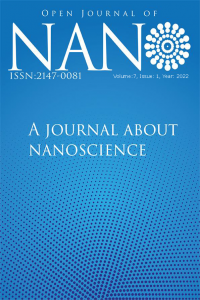Research Article
Issue Editorial Board


Aim & Scope
The journal aims to also publish articles (but not limited to) at the forefront of nanoscale science and/or technology and especially those of an interdisciplinary nature.
The aim of The Open Journal of Nano (OJN) is to contribute to science, education and industry by reaching a wide area in the field of nano and micro size materials and their applications, which have an interdisciplinary character at national and international level. For this purpose, special issues are published 2 times a year and in line with the recommendations of the editorial board. Studies are evaluated by the editors after at least two national and international referee reports according to the principles of blind refereeing.
OJN contains theoretical and practical high-quality original research articles, technical review articles, literature summary and editorial publications in the fields of all disciplines of Science and Engineering related to nano- and micro-size materials and their applications.
The Open Journal of Nano is deal with (but not limited to) knowledge of the physical, chemical and biological phenomena and processes related to particles, tubes, layers, macromolecules, clusters and other finite structures that have at least one lengthscale ranging from molecular to nanoscale, and exhibit improved and novel properties that are a direct result of their small size.
OJN scope primarily addresses the following three main topics:
- Micro-/Nano- fabrication, synthesis, devices, biosysytems and integration of functional micro-nanostructures
- Micro and Nano Engineering
- Materials characterization
- Material properties
- Computational materials science and modeling
- Material applications
- Material Chemistry
- Synthesis and fabrication
- Metallurgy
- Alloys
- Ferrous and non-ferrous metals
- Intermetallic
- Composite
- Nanotechnology
- Welding
- Manufacturing
- Processing
- Engineering applications of materials
- Energy
- Engineering technology
- Multi-disipcinary studies in engineering
Author Guidelines
Towards ensuring high editorial standards, every article submission is preliminarily assessed by the editors of the journal before being sent to at least two (2) independent referees.
The following formal principles should be followed in the manuscripts sent to the journal for publication:
- Articles should be written in English or Turkish. English title, abstract and keywords sections are mandatory for manuscripts written in Turkish.
- The submitted manuscript must not have been previously published or submitted to any journal for consideration (or an explanation should be made in the Notes to the Editor).
- Each author's ORCID number (https://orcid.org/) must be submitted.
- The submission file must be in Microsoft Word document file format.
- URLs and DOI numbers of references should be given where available.
- Text; All figures, pictures and tables should be submitted in the text, with single-spaced, 10-point font, italicized instead of underlined (except URL addresses). For printing, quality copies of the pictures (in JPG or TIFF format) should be sent as an attachment file.
- The title of the article should be appropriate and understandable to the content of the article. All headings should be written in bold font.
- Acknowledgments regarding the individual or institutional financial support provided for the research should be included in a separate section at the end of the article.
- All article sections except the abstract, acknowledgments and reference sections should be numbered. The manuscript should be arranged in the form of Abstract, Main Text, Acknowledgments (if necessary) and References.
- Mathematical expressions should be written using the "Equation Editor". Mathematical expressions should be numbered in parentheses.
- Template word file can be examined for article title flow and other details.
- When preparing your manuscript, please use for reference management programs like Mendeley or Zatero.
- Graphical Abstract is not mandority of manuscript. It is fast summary grabbing material so readers can quickly have an idea about the article. It is advised to prepare.
Template for articles: Template Word
Copyright Form: https://docs.google.com/document/d/1Cf6Tjswv9YHTx-gCb0XxuodsJumfow0P/edit?usp=sharing&ouid=107485029693438494516&rtpof=true&sd=true
Legal Requirements
The author(s) guarantee(s) that the manuscript is/will not be published elsewhere in any language without the consent of the copyright holders, that the rights of third parties will not be violated, and that the publisher will not be held legally responsible should there be any claims for compensation.
Authors wishing to include figures or text passages that have already been published elsewhere are required to obtain permission from the copyright holder(s) and to include evidence that such permission has been granted when submitting their papers. Any material received without such evidence will be assumed to originate from the authors.
The author(s) are encouraged to transfer the copyright of the article to the publisher upon acceptance of an article by the journal, using the Authors' Warranty and Assignment of Copyright agreement. This transfer enables the Editor to protect the copyrighted material for the authors, but does not relinquish the authors' proprietary rights. The publication of an article is conditioned by the signature of the author to whom correspondence should be addressed on this Authors' Warranty and Assignment of Copyright that is provided by the Editor.
Page charge
There is no charge per printed page.
Privacy Statement
The names and email addresses entered in this journal site will be used exclusively for the stated purposes of this journal and will not be made available for any other purpose or to any other party.
Ethical Principles and Publication Policy
Peer Review Policy
The Open Journal of Nano (OJN), applies double blind peer-review process in which both the reviewer and the author are anonymous. Reviewer selection for each submitted article is up to area editors, and reviewers are selected based on the reviewer’s expertise, competence, and previous experience in reviewing papers for OJN.
Every submitted article is evaluated by area editor, at least, for an initial review. If the paper reaches minimum quality criteria, fulfills the aims, scope and policies of OJN, it is sent to at least two reviewers for evaluation.
The reviewers evaluate the paper according to the Review guidelines set by editorial board members and return it to the area editor, who conveys the reviewers' anonymous comments back to the author. Anonymity is strictly maintained.
The latest statistics of the submitted article publication process:
- Evaluation period (Time between journal submission of a manuscript and its decision): 30-90 days
- Early publication time (Time between journal submission of a manuscript and publication in early view): 60-120 days
- Publication Period (Time between journal submission of a manuscript and its publication) 60-120 days
The double blind peer-review process is managed using “ULAKBİM Dergi Sistemleri”, namely Dergipark platform.
Open Access Policy
OJN provides immediate open access for all users to its content on the principle that making research freely available to the public, supporting a greater global exchange of knowledge.
Archiving Policy
Authors can deposit a copy of their paper in an institutional or other repository of their choice. Submitted, Accepted (Author Accepted Manuscript), Published versions (Version of Record) or any other versions are allowed without embargo.
OJN is accessed by Dergipark platform which utilizes the LOCKSS system to create a distributed archiving system among participating libraries and permits those libraries to create permanent archives of the journal for purposes of preservation and restoration.
Originality and Plagiarism Policy
Authors by submitting their manuscript to OJN declare that their work is original and authored by them; has not been previously published nor submitted for evaluation; original ideas, data, findings and materials taken from other sources (including their own) are properly documented and cited; their work does not violate any rights of others, including privacy rights and intellectual property rights; provided data is their own data, true and not manipulated. Plagiarism in whole or in part without proper citation is not tolerated by OJN. Manuscripts submitted to the journal will be checked for originality using anti-plagiarism software.
The similarity percentages in the plagiarism reports are purely for the purpose of informing the editors during the plagiarism review phase. Expressions that are found to be taken from a source as verbatim sentences and/or phrases, especially in the sections of articles containing original information and comments, such as the "Results and Discussions" heading, are considered to be plagiarism even if they are cited. Appropriate citations are given to the places where these expressions are taken, and it is expected to be included in the text with the narration of the article author. It is expected to be rewritten with the narration of the article author by giving appropriate references to the places where these statements were taken.
Journal Ethics and Malpractice Statement
For all parties involved in the publishing process (the author(s), the journal editor(s), the peer reviewers, the society, and the publisher) it is necessary to agree upon standards of expected ethical behavior. The ethics statements for OJN are based on the Committee on Publication Ethics (COPE) Code of Conduct guidelines available at www.publicationethics.org.
1. Editor Responsibilities
Publication Decisions & Accountability
The editor of OJN is responsible for deciding which articles submitted to the journal should be published, and, moreover, is accountable for everything published in the journal. In making these decisions, the editor may be guided by the journal’s editorial board and/or area editors, and considers the policies of the journal. The editor should maintain the integrity of the academic record, preclude business needs from compromising intellectual and ethical standards, and always be willing to publish corrections, clarifications, retractions, and apologies when needed.
Fair play
The editor should evaluate manuscripts for their intellectual content without regard to race, gender, sexual orientation, religious belief, ethnic origin, citizenship, or political philosophy of the author(s).
Confidentiality
The editor and any editorial staff must not disclose any information about a submitted manuscript to anyone other than the corresponding author, reviewers, potential reviewers, other editorial advisers, and the publisher, as appropriate.
Disclosure, conflicts of interest, and other issues
The editor will be guided by COPE’s Guidelines for Retracting Articles when considering retracting, issuing expressions of concern about, and issuing corrections pertaining to articles that have been published in OJN.
Unpublished materials disclosed in a submitted manuscript must not be used in an editor’s own research without the explicit written consent of the author(s). Privileged information or ideas obtained through peer review must be kept confidential and not used for personal advantage.
The editor should seek so ensure a fair and appropriate peer-review process. The editor should recuse himself/herself from handling manuscripts (i.e. should ask a co-editor, associate editor, or other member of the editorial board instead to review and consider) in which they have conflicts of interest resulting from competitive, collaborative, or other relationships or connections with any of the authors, companies, or (possibly) institutions connected to the papers. The editor should require all contributors to disclose relevant competing interests and publish corrections if competing interests are revealed after publication. If needed, other appropriate action should be taken, such as the publication of a retraction or expression of concern.
2. Reviewer Responsibilities
Contribution to editorial decisions
Peer review assists the editor in making editorial decisions and, through the editorial communication with the author, may also assist the author in improving the manuscript.
Promptness
Any invited referee who feels unqualified to review the research reported in a manuscript or knows that its timely review will be impossible should immediately notify the editor so that alternative reviewers can be contacted.
Confidentiality
Any manuscripts received for review must be treated as confidential documents. They must not be shown to or discussed with others except if authorized by the editor.
Standards of objectivity
Reviews should be conducted objectively. Personal criticism of the author(s) is inacceptable. Referees should express their views clearly with appropriate supporting arguments.
Acknowledgement of sources
Reviewers should identify relevant published work that has not been cited by the author(s). Any statement that an observation, derivation, or argument had been previously reported should be accompanied by the relevant citation. Reviewers should also call to the editor’s attention any substantial similarity or overlap between the manuscript under consideration and any other published data of which they have personal knowledge.
Disclosure and conflict of interest
Privileged information or ideas obtained through peer review must be kept confidential and not used for personal advantage. Reviewers should not consider evaluating manuscripts in which they have conflicts of interest resulting from competitive, collaborative, or other relationships or connections with any of the authors, companies, or institutions connected to the submission.
3. Author Responsibilities
Reporting standards
Authors reporting results of original research should present an accurate account of the work performed as well as an objective discussion of its significance. Underlying data should be represented accurately in the manuscript. A paper should contain sufficient detail and references to permit others to replicate the work. Fraudulent or knowingly inaccurate statements constitute unethical behavior and are unacceptable.
Originality and plagiarism
The authors should ensure that they have written entirely original works, and if the authors have used the work and/or words of others that this has been appropriately cited or quoted.
Multiple, redundant, or concurrent publication
An author should not in general publish manuscripts describing essentially the same research in more than one journal or primary publication. Parallel submission of the same manuscript to more than one journal constitutes unethical publishing behavior and is unacceptable.
Acknowledgement of sources
Proper acknowledgment of the work of others must always be given. Authors should also cite publications that have been influential in determining the nature of the reported work.
Authorship of a manuscript
Authorship should be limited to those who have made a significant contribution to the conception, design, execution, or interpretation of the reported study. All those who have made significant contributions should be listed as co-authors. Where there are others who have participated in certain substantive aspects of the research project, they should be named in an Acknowledgement section. The corresponding author should ensure that all appropriate co-authors are included in the author list of the manuscript, and that all co-authors have seen and approved the final version of the paper and have agreed to its submission for publication. All co-authors must be clearly indicated at the time of manuscript submission. Request to add co-authors, after a manuscript has been accepted will require approval of the editor.
Hazards and human or animal subjects
If the work involves chemicals, procedures, or equipment that has any unusual hazards inherent in their use, the authors must clearly identify these in the manuscript. Additionally, manuscripts should adhere to the principles of the World Medical Association (WMA) Declaration of Helsinki regarding research study involving human or animal subjects.
Disclosure and conflicts of interest
All authors should disclose in their manuscript any financial or other substantive conflict of interest that might be construed to influence the results or their interpretation in the manuscript. All sources of financial support for the project should be disclosed.
Fundamental errors in published works
In case an author discovers a significant error or inaccuracy in his/her own published work, it is the author’s obligation to promptly notify the journal’s editor to either retract the paper or to publish an appropriate correction statement or erratum.
4. Publisher Responsibilities
Editorial autonomy
Mustafa CAN (Publisher) is committed to working with editors to define clearly the respective roles of publisher and of editors in order to ensure the autonomy of editorial decisions, without influence from advertisers or other commercial partners.
Intellectual property and copyright
We protect the intellectual property and copyright of Publisher, its imprints, authors and publishing partners by promoting and maintaining each article’s published version of record. Publisher ensures the integrity and transparency of each published article with respect to: conflicts of interest, publication and research funding, publication and research ethics, cases of publication and research misconduct, confidentiality, authorship, article corrections, clarifications and retractions, and timely publication of content.
Scientific Misconduct
In cases of alleged or proven scientific misconduct, fraudulent publication, or plagiarism the publisher, in close collaboration with the editors, will take all appropriate measures to clarify the situation and to amend the article in question. This includes the prompt publication of a correction statement or erratum or, in the most severe cases, the retraction of the affected work.
Price Policy
No fee is required (no article submission, processing, or publication charges).
The Open Journal of Nano(OJN) deals with information related to (but not limited to) physical, chemical and biological phenomena and processes ranging from molecular to microscale structures.
All publications in The Open Journal of Nano are licensed under the Attribution-NonCommercial 4.0 International (CC BY-NC 4.0) license.


